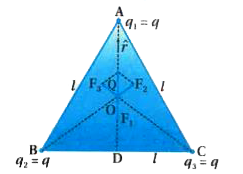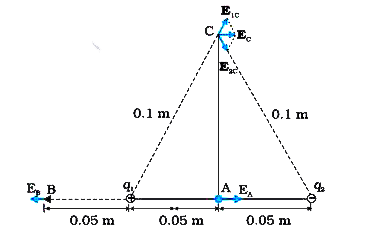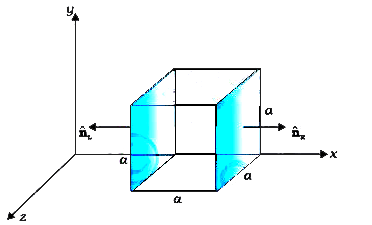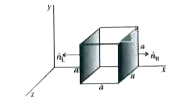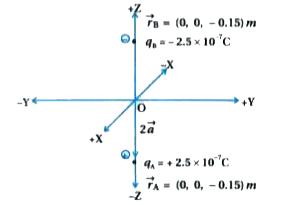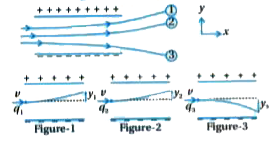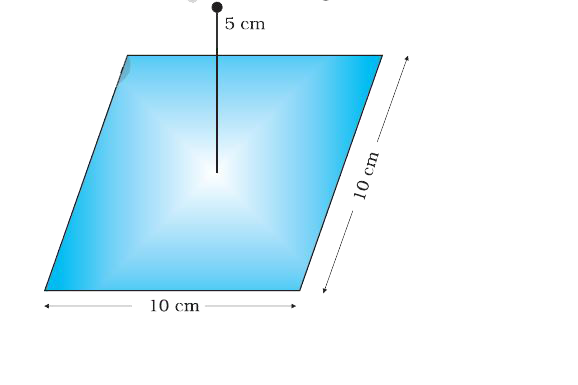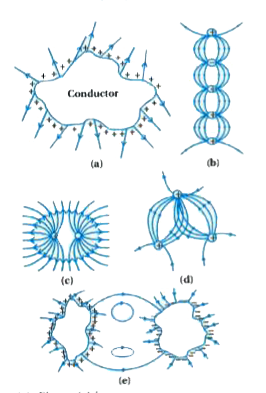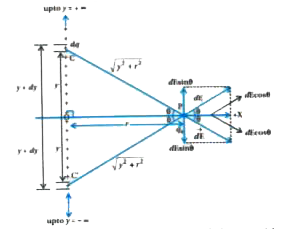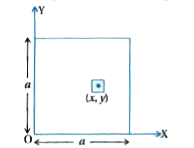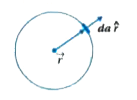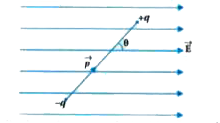SECTION B NUMERICALS (NUMERICAL FROM TEXTUAL EXERCISES) from KUMAR PRAKASHAN KENDRA PHYSICS (GUJRATI ENGLISH) ELECTRIC CHARGES AND FIELDS for Class 12
| Class 12 | PHYSICS |
| Chapter | ELECTRIC CHARGES AND FIELDS |
| KUMAR PRAKASHAN KENDRA PHYSICS (GUJRATI ENGLISH) | SECTION B NUMERICALS (NUMERICAL FROM TEXTUAL EXERCISES) |
| Medium | English |
| Academic Year | 2023-2024 |
Question 4
Coulomb's law for electrostatic force between two point charges and Newton's law for gravitational force between two stationary point masses, both have inverse-square dependence on the distance between the charges and masses respectively,
(a) Compare the strength of these forces by determining the ratio of their magnitudes (i) for an electron and a proton and (ii) for two protons.
(b) Estimate the accelerations of electron an proton due to the electrical force of the mutual attraction when they are =10−10m apart?
(mp=1.67×10−27kg,me=9.11×10−31kg)
 View Solution
View SolutionQuestion 5
A charged metallic sphere A is suspended by a nylon thread. Another charged metallic sphere B held by an insulating handle is brought close to A such that the distance between their centres is 10 cm, as shown in figure (a). The resulting repulsion of A is noted (for example, by shining a beam of light and measuring the deflection of its shadow on a screen). Spheres A and B are touched by uncharged spheres C and D respectively, as shown in figure (b). C and D are then removed and B is brought closer to A to a distance of 5.0 cm between their centres, as shown in figure (c). What is the expected repulsion of A on the basis of Coulomb's law ? Spheres A and C and spheres B and D have identical sizes. Ignore the sizes of A and B in comparison to the separation between their centres.
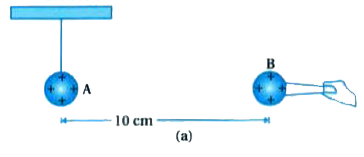
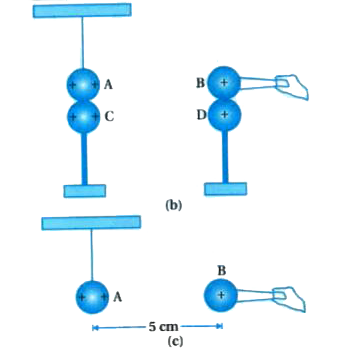 View Solution
View SolutionQuestion 10
Tow charges ±10μ C are placed 5.0 mm apart determine the electric field at (a) a point p on the axis of the dipole 15 cm away from its centre o ont the side of the positive charge as (a) and (b) a point q 15 cm away from o on a line passing through o and normal to the axis of the dipole as
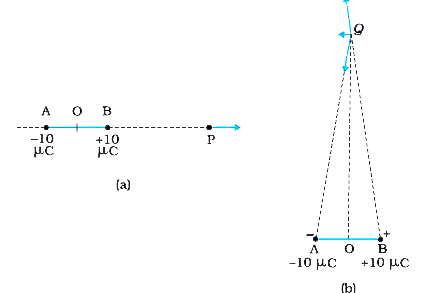 View Solution
View SolutionQuestion 12
An electric field is uniform and in the positive x direction for positive x and uniform with the same magnitude but in the negative x direction for negative x. It is given that E=200ˆiN/C and E=−200ˆiNCfor x<0. A right circular cylinder of length 20 cm and radius 5 cm has its centre at the origin and its axis along the *-axis so that one face is at jc = + 10 cm and the other is at x = - 10 cm as shown in figure, (a) What is the net outward flux through each flat face ? (b) What is the flux through the side of the cylinder ? (c) What is the net outward flux through the cylinder ? (d) What is the net charge inside the cylinder ?
 View Solution
View SolutionQuestion 13
An early model for an atom considered it to have a positively charged point nucleus of charge Ze, surrounded by a uniform density of negative charge up to a radius R. The atom as a whole is neutral. For this model, what is the electric field at a distance r from the nucleus ?
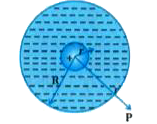 View Solution
View SolutionQuestion 17
Charges on identical spheres A and B are equal. When the separation between them is 1 m, the repulsion between them is 80 N. Now, another identical and uncharged sphere C is brought in contact with A and then separated. Then, C is brought in contact with B and then separated. What will be the new force between A and B ?View SolutionQuestion 20
An electron falls through a distance of 2 cm ir a uniform electric field of magnitude 6.0×104NC−1 figure (a). The direction of the field is reversed keeping its magnitude unchanged and a proton falls through the same distance figure (b). Compute the time of fall ir each case. Contrast the situation with that oi 'free fall under gravity'.
me=9.1×10−31kg,mp=1.7×10−27kg and e=1.6×10−19 C
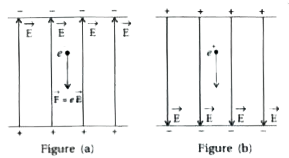 View Solution
View SolutionQuestion 32
Two point charges qA=3μC and qB=−3μC are located 20 cm apart in vacuum.
(a) What is the electric field at the midpoint O of the line AB joining the two charges ?
(b) If a negative test charge of magnitude 1.5×10−9 C is placed at this point, what is the force experienced by the test charge ?
 View Solution
View SolutionQuestion 36
(a) Two insulated charged copper spheres a and b have their centres separated by a distance of 50 cm what is the nutual force of electrostatic repulsion if the charge on each is 6.5×10−7 c the radii of a and b negligible compared to the distance of separation
(b) what is the force of repuslion if each spere is charged double the above amount andf the distance between them is haved View SolutionQuestion 37
Suppose the spheres A and B in Exercise 1.12 have identical sizes. A third sphere of the same size but unchanged is brought in contact with the first , then brought in contact with the second, and finally removed from both. What is the new force of repulsion between A and B ?View SolutionQuestion 41
Careful measurement of the electric field at the surface of a black box indicates that the net outward flux through the surface of the box is 8.0×103Nm2/C.
(a) What is the net charge inside the box ?
(b) If the net outward flux through the surface of the box were zero, could you conclude that there were no charges inside the box ? Why or Why not ?View SolutionQuestion 44
A point charge causes an elelctric flux of −1.0×103Nm2C to pass through a spherical gaussioan of 10.0 cm radius centred on the charge (a) if the radius of the gaussian surface wrere doubled how much flux would pas through the surface (b) what is the value of the point charge View SolutionQuestion 51
In a certain region of space, electric field is along the z-direction throughout. The magnitude of electric field is, however, not constant but increases uniformly along the positive z-direction, at the rate of 105NC−1 per meter. What are the force and torque experienced by a system having a total dipole moment equal to 10−7 cm in the negative z-direction ?View SolutionQuestion 52
(a) A conductor A with a cavity as shown in figure (a) is given a charge Q. Show that the entire charge must appear on the outer surface of the conductor.
(b) Another conductor B with charge q is inserted into the cavity keeping B insulated from A. Show that the total charge on the outside surface of A is Q+q figure (b)
( C) A sensitive instruments is to be shielded from the strong electrostatic fields in its environment. Suggest a possible way.
 View Solution
View SolutionQuestion 55
It is now believed that protons and neutrons (which constitute nuclei of ordinary matter) are themselves built out of more elementary units called quarks. A proton and a neutron consist of three quarks each. Two types of quarks, the so called 'up' quark (denoted by u)
of charge +23e and the down quark denoted by d) of charge (−13e), together with electrons build up ordinary matter. (Quarks of other types have also been found which give rise to different unusual varieties of matter.) Suggest a possible quark composition of a proton and neutron.View SolutionQuestion 56
(a) Consider an arbitrary electrostatic field configuration. A small test charge is placed at a null point (i.e., where E = 0) of the configuration. Show that the equilibrium of the test charge is necessarily unstable.
(b) Verify this result for the simple configuration of two charges of the same magnitude and sign placed a certain distance apart.View SolutionQuestion 57
A particle of mass m and charge (-q) enters the region between the two charged plates initially moving along x-axis with speed vx (like particle 1 in figure. The length of plate is L and an uniform electric field E is maintained between the plates. Show that the vertical deflection of the particle at the far edge of the plate is qEL2/(2mv2x).
Compare this motion with motion of a projectile in gravitational field discussed in Section 4.10 of Class XI Textbook of Physics.
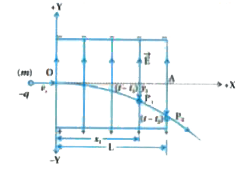 View Solution
View SolutionQuestion 59
Two spheres of copper, having mass 1 g each, are kept 1 m apart. The number of electrons in them are 1 % less than the number of protons. The electrical force between them is Atomic wt. of copper is 63.54 g/mol, atomic number is 29, Avogadro's number NA=6.023×1023mol−1 and k=9×109 SIView SolutionQuestion 64
An electric dipole is prepared by taking two electric charges of 2×10−8 C separated by distance 2 mm. This dipole is kept near a line charge distribution having density 4×10−4 C/m in such a way that the negative electric charge of the dipole is at a distance 2 cm from the wire as shown in the figure. Calculate the force acting on the dipole.
[Take k=14πε0=9×109Nm2C−2]
 View Solution
View Solution
All Exercises from KUMAR PRAKASHAN KENDRA PHYSICS (GUJRATI ENGLISH) Class 12 PHYSICS ELECTRIC CHARGES AND FIELDS
- SECTION A QUESTIONS- ANSWERS
- SECTION A QUESTIONS- ANSWERS ( HIGHER ORDER THINKING SKILLS (HOTS) UNIFICATION OF ELECTRICITY AND MAGNETISM)
- SECTION A QUESTIONS- ANSWERS (ADDITIVITY OF CHARGES)
- SECTION A QUESTIONS- ANSWERS (APPLICATION OF GAUSS.S LAW)
- SECTION A QUESTIONS- ANSWERS (BASIC PROPERTIES OF ELECTRIC CHARGE)
- SECTION A QUESTIONS- ANSWERS (CHARGE IS CONSERVED)
- SECTION A QUESTIONS- ANSWERS (CHARGING BY INDUCTION)
- SECTION A QUESTIONS- ANSWERS (CONDUCTORS AND INSULATORS)
- SECTION A QUESTIONS- ANSWERS (CONTINOUS CHARGE DISTRIBUTION)
- SECTION A QUESTIONS- ANSWERS (COULOMB.S LAW)
- SECTION A QUESTIONS- ANSWERS (DIPOLE IN UNIFORM EXTERNAL FIELD)
- SECTION A QUESTIONS- ANSWERS (ELECTRIC DIPOLE)
- SECTION A QUESTIONS- ANSWERS (ELECTRIC FIELD LINES)
- SECTION A QUESTIONS- ANSWERS (ELECTRIC FLUX)
- SECTION A QUESTIONS- ANSWERS (FIELD DUE TO A UNIFORMLY CHARGED THIN SPHERICAL SHELL)
- SECTION A QUESTIONS- ANSWERS (FIELD DUE TO AN INFINITELY LONG STRAIGHT UNIFORMLY CHARGED WIRE)
- SECTION A QUESTIONS- ANSWERS (FIELD DUE TO AN UNIFORMLY CHARGED INFINITE PLANE SHEET)
- SECTION A QUESTIONS- ANSWERS (FORCES BETWEEN MULTIPLE CHARGES)
- SECTION A QUESTIONS- ANSWERS (GAUSS.S LAW)
- SECTION A QUESTIONS- ANSWERS (PHYSICAL SIGNIFICANCE OF DIPOLES)
- SECTION A QUESTIONS- ANSWERS (THE FIELD OF AN ELECTRIC DIPOLE)
- SECTION A QUESTIONS- ANSWERS (TRY YOURSELF )
- SECTION B NUMERICALS (ADDITONAL EXERCISE)
- SECTION B NUMERICALS (NUMERICAL FOR .DARPAN. BASED ON TEXTBOOK)
- SECTION B NUMERICALS (NUMERICAL FROM TEXTUAL EXERCISES)
- SECTION B NUMERICALS (NUMERICAL FROM TEXTUAL ILLUSTRATIONS)
- SECTION C NCERT EXEMPLAR SOLUTION (LONG ANSWER TYPE QUESTIONS)
- SECTION C NCERT EXEMPLAR SOLUTION (MULTIPLE CHOICE QUESTIONS (MCQS))
- SECTION C NCERT EXEMPLAR SOLUTION (MULTIPLE CHOICE QUESTIONS (MORE THAN ONE OPTION))
- SECTION C NCERT EXEMPLAR SOLUTION (SHORT ANSWER TYPE QUESTIONS)
- SECTION C NCERT EXEMPLAR SOLUTION (VERY SHORT ANSWER TYPE QUESTIONS)
- SECTION D (MULTIPLE CHOICE QUESTIONS (MCQS)) (MCQS FROM .DARPAN. BASED ON TEXTBOOK) (ASSERTION AND REASON TYPE MCQS)
- SECTION D (MULTIPLE CHOICE QUESTIONS (MCQS)) (MCQS FROM .DARPAN. BASED ON TEXTBOOK) (CONTINUOUS DISTRIBUTION OF CHARGE AND ELECTRIC FLUX)
- SECTION D (MULTIPLE CHOICE QUESTIONS (MCQS)) (MCQS FROM .DARPAN. BASED ON TEXTBOOK) (ELECTROSTATIC ELECTRIC CHARGE AND FRICTIONAL ELECTRICAL CHARGE)
- SECTION D (MULTIPLE CHOICE QUESTIONS (MCQS)) (MCQS FROM .DARPAN. BASED ON TEXTBOOK) (LECTRIC FIELD AND ELECTRIC DIPOLE)
- SECTION D (MULTIPLE CHOICE QUESTIONS (MCQS)) (MCQS FROM .DARPAN. BASED ON TEXTBOOK) (MISCELLANEOUS MCQS)
- SECTION D MCQS ASKED IN COMPETITIVE EXAMES (MCQS AKSED IN BOARD EXAM AND GUJCET)
- SECTION D MCQS ASKED IN COMPETITIVE EXAMES (MCQS ASKED IN AIEEE AND JEE MAINS)
- SECTION D MCQS ASKED IN COMPETITIVE EXAMES (MCQS ASKED IN CBSE-PMT AIPMT NEET)

